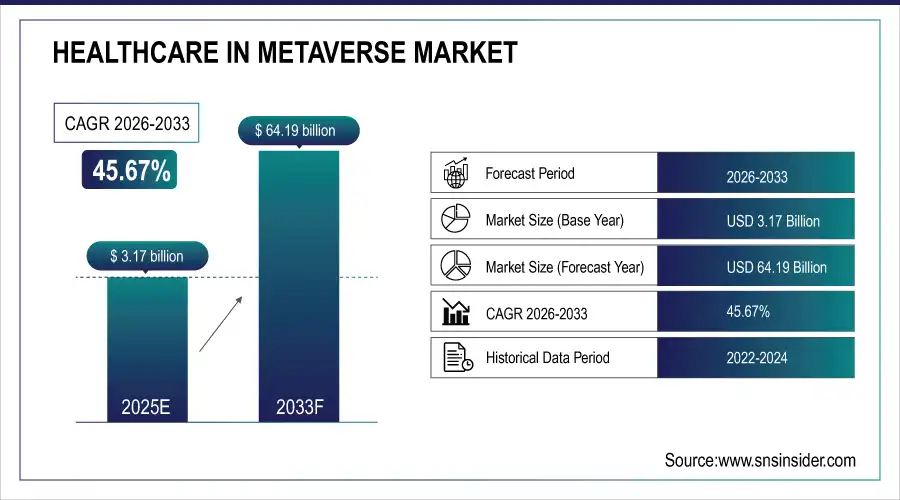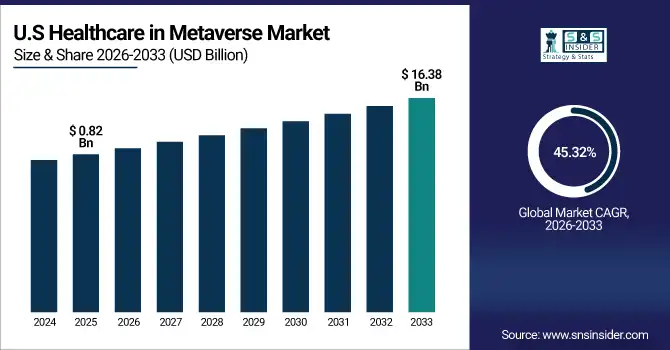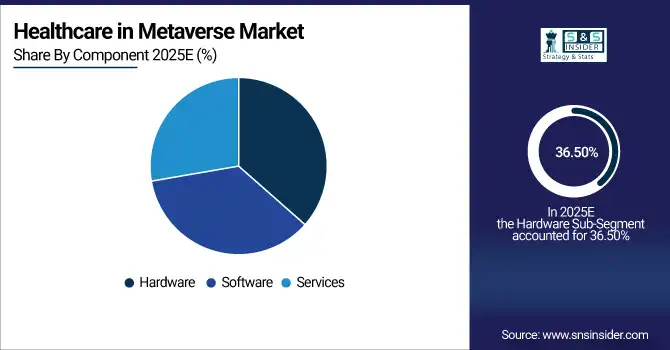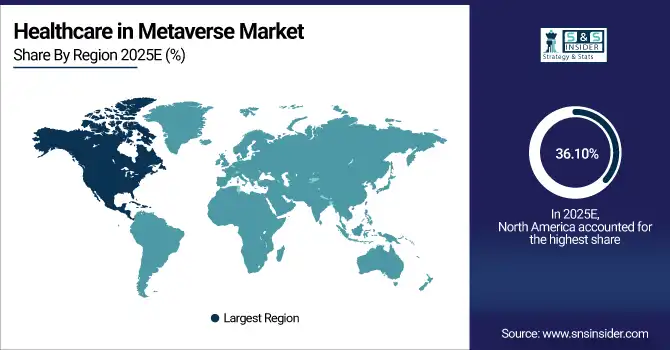Healthcare in Metaverse Market Report Scope & Overview:
The Healthcare in Metaverse Market Size was valued at USD 3.17 Billion in 2025E and is expected to reach USD 64.19 Billion by 2033 and grow at a CAGR of 45.67% over the forecast period 2026-2033.
The Healthcare in Metaverse Market analysis growth is rapidly growing in hospitals, universities, and clinics adopt immersive technologies, such as augmented reality (AR), virtual reality (VR), and artificial intelligence (AI), for medical training, surgical planning, and patient care. Hospitals and medical centers are using virtual simulations to decrease procedural errors, increase information retention among medical professionals, and do telemedicine consults. Growing desire for telemedicine and remote patient monitoring, especially in rural and underserved areas, is also propelling the adoption of metaverse platforms and they will make healthcare more accessible, scalable, and efficient. According to study, Hospitals using AR/VR simulations report up to 30–40% reduction in procedural errors among trained healthcare professionals.
Market Size and Forecast:
-
Market Size in 2025: USD 3.17 Billion
-
Market Size by 2033: USD 64.19 Billion
-
CAGR: 45.67% from 2026 to 2033
-
Base Year: 2025
-
Forecast Period: 2026–2033
-
Historical Data: 2022–2024

To Get more information On Healthcare in Metaverse Market - Request Free Sample Report
Healthcare in Metaverse Market Trends
-
Rapid adoption of AR/VR for immersive medical training and simulations.
-
Integration of AI enabling predictive analytics and personalized patient care.
-
Expansion of telemedicine improving accessibility in rural and underserved regions.
-
Growing use of wearable IoT devices for remote patient monitoring.
-
Investment in virtual platforms to reduce procedural errors and training costs.
-
Increasing focus on digital health solutions for proactive and preventive care.
The U.S. Healthcare in Metaverse Market size was USD 0.82 Billion in 2025E and is expected to reach USD 16.38 Billion by 2033, growing at a CAGR of 45.32% over the forecast period of 2026-2033, driven by advanced healthcare infrastructure, strong R&D investment, and growing demand for innovative, scalable digital health solutions.

Healthcare in Metaverse Market Growth Drivers:
-
Immersive Technologies Revolutionize Healthcare Training, Surgery, Diagnostics, And Patient Care Globally
The Healthcare in Metaverse Market is growing worldwide driven by, growing utilization of Immersive technologies including Augmented Reality (AR), Virtual Reality (VR), and Artificial Intelligence (AI). Hospitals, medical centers, and training institutes are employing AR/VR solutions for surgical planning and medical training, conducted in a risk-free virtual environment where healthcare professionals can practice complex procedures in virtual simulation. This means that integrating AI allows for more precise diagnostics and tailored treatments while also enabling predictive analytics and virtual patience’s to be simulated. From reducing procedural errors, and training costs to enhancing.
Immersive AR/VR training can reduce surgical and procedural errors by 30–40%.
Healthcare in Metaverse Market Restraints:
-
High Implementation Costs And Infrastructure Hinder Widespread Metaverse Adoption
Despite its advantages, Healthcare in Metaverse Market faces challenges in the high cost of implementation and the need for advanced infrastructure. Virtual reality and augmented reality devices, haptic feedback systems, and AI-powered platforms are capital-intensive and could be a challenge to deploy in small hospitals or clinics, particularly in developing regions. Moreover, it adds an operational complexity to set up secure & high-speed connectivity, cloud storage, and integration with existing Electronic medical records (EMR/EHR) systems. Such factors constrain mass adoption and hinder market penetration by teething the use of technology in areas with budget enormities or poor digital infrastructure.
Healthcare in Metaverse Market Opportunities:
-
Telemedicine Expansion Boosts Remote Monitoring, Accessibility, And Proactive Healthcare Delivery
The Healthcare in Metaverse Market presents a significant opportunity in telemedicine and remote patient monitoring to populations in rural and underserved areas. The metaverse platforms allow doctors to offer virtual consultations and track patient vitals through wearable IoT devices, enabling them to provide personalized care while staying away. Not only does it address health care accessibility issues, but it also helps to prevent hospital overcrowding, and it saves costs for patients traveling. With governments and healthcare organizations doubling down on digital health, the opportunity to scale metaverse immersive experiences, smooth the integration of AI-powered diagnostics, and expand patient participation will advance a more active and preventive model of health care system.
Virtual healthcare platforms can reduce in-person hospital visits by 25–35%, easing operational load.
Healthcare in Metaverse Market Segmentation Analysis:
-
By Component: In 2025, Hardware led the market with a share of 36.50%, while Services is the fastest-growing segment with a CAGR of 35.78%.
-
By Technology: In 2025, AR and VR led the market with a share of 34.06%, while Artificial Intelligence is the fastest-growing segment with a CAGR of 36.10%.
-
By Application: In 2025, Telemedicine led the market with a share of 32.10%, while Medical Training and Simulation is the fastest-growing segment with a CAGR of 45.12%.
-
By End-use: In 2025, Medical Centers led the market with a share of 35.06%, while Biotech and Pharmaceutical Companies is the fastest-growing segment with a CAGR of 44.60%.
By Component, Hardware Leads Market and Services Fastest Growth
In the Healthcare in Metaverse Market, the Hardware lead in 2025, driven by widespread adoption of AR/VR devices, haptic feedback systems, and other immersive tools essential for medical training, surgical planning, and patient rehabilitation. This is why hospitals and medical centers are investing in these devices to help with more accurate, error-free procedures as well as increased learning retention for healthcare professionals. Meanwhile, the services segment is expected to grow at the highest CAGR due to improvements in telemedicine, virtual consultations, remote patient monitoring, and AI-powered diagnostic. The metaverse healthcare ecosystem encompasses a variety of offerings, but service-based solutions stand out as a significant growth driver, especially to deliver scalable, affordable, customized, and accessible healthcare solutions in rural and underserved areas.

By Technology, AR and VR Lead Market and Artificial Intelligence Fastest Growth
In the Healthcare in Metaverse Market, the AR and VR lead in 2025, Due to the role immersive technologies play in medical training, surgical simulations, rehabilitation, and patient engagement. AR/VR devices are being adopted by hospitals and medical centers to provide immersive, risk-free environments that increase knowledge retention, procedural precision, and clinical judgment. Meanwhile, the Artificial Intelligence (AI) segment is the fastest-growing as it enables predictive analytics, personalized treatment planning, virtual patient monitoring, and AI-assisted diagnostics. AI provides a strong catalyst for innovation and rapid adoption of the metaverse health ecosystem, since it allows for increased efficiency, scalability and data-driven healthcare delivery as part of AR/VR platforms.
By Application, Telemedicine Leads Market and Medical Training & Simulation Fastest Growth
In the Healthcare in Metaverse Market, Telemedicine leads the market in 2025, the growing need for remote consultations, virtual check-ups, and patient monitoring, especially in rural and underserved areas. Telemedicine platforms allow doctors to provide individualized treatment, ease pressure on hospital facilities, and provide patients with better access to healthcare without travel costs. Meanwhile, the medical training and simulation segment is experiencing the fastest growth, due to the implementation of AR/VR technologies for immersive education. Such platforms also enable healthcare professionals to rehearse intricate procedures in safe virtual environments, helping to increase procedural precision, decrease inaccuracies and boost learning retention and making medical education quicker and scalable.
By End-use, Medical Centers Lead Market and Biotech & Pharmaceutical Companies Fastest Growth
In the Healthcare in Metaverse Market, the Medical Centers leads in 2025, due to the hospitals and clinics have widely adopted AR/VR and AI-powered immersive technologies in surgical planning, patient rehabilitation, virtual consultations, and staff training. Using metaverse platforms, these centers are able to improve the accuracy of procedures, efficiency in operations, and offer scalable healthcare services to a larger number of patients. Meanwhile, the segmentation of biotech and pharmaceutical companies is growing most rapidly, due to incorporating metaverse solutions in virtual labs, AI-based drug detection, clinical trials and patient monitoring. These innovations result in faster, cheaper, and more engaging R&D processes that colourful metaverse technologies revolutionize once applied in research and pharmaceutical settings.
Healthcare in Metaverse Market Regional Analysis:
North America Healthcare in Metaverse Market Insights:
The North America dominated the Healthcare in Metaverse Market in 2025E, with over 36.10% revenue share, driven by advanced healthcare infrastructure, an extensive adoption of digital health technologies, and major investments by healthcare companies across regions for AR/VR and AI solutions. A slew of hospitals, medical centers, and research institutes is rushing to use metaverse platforms for surgical simulations, medical training, telemedicine, and remote patient monitoring. Market expansion is also driven by the presence of prominent technology companies, extensive R&D activity, and supportive regulatory policy. This is aided by the rising need for immersive medical teaching, increasing patient involvement, and virtual clinical trials. North America have been projected to continue as export leaders due to its continuous innovations and integration of technology across healthcare services.

Get Customized Report as per Your Business Requirement - Enquiry Now
-
U.S. Healthcare in Metaverse Market Insight
The U.S. leads adoption of AR/VR and AI technologies, driving telemedicine, virtual training, remote monitoring, and immersive healthcare solutions, supported by advanced infrastructure and strong investment trends.
Asia Pacific Healthcare in Metaverse Market Insights:
The Asia-Pacific region is expected to have the fastest-growing CAGR 47.15%, due to the rapid digital transformation, rising penetration of AR/VR and AI technologies and increasing investment in healthcare infrastructure. Telemedicine, remote patient monitoring, and virtual medical training are all in high demand, especially in rural or underserved areas. The region benefits from an increasing number of tech providers and health start-ups, along with government initiatives supporting digital health solutions, the region has experienced much progress. The increasing awareness of immersive healthcare applications, economical virtual training, and AI-assisted diagnostics, among others, further contributes to the growth of the market, making Asia-Pacific a potential early adopter of metaverse-based healthcare solutions.
-
China and India Healthcare in Metaverse Market Insight
China and India are rapidly expanding Healthcare in Metaverse Markets, driven by rapidly adopting digital health technologies, including AR/VR and AI, driving telemedicine, remote monitoring, and virtual training, supported by growing healthcare investments and infrastructure.
Europe Healthcare in Metaverse Market Insights
Europe is the second-largest Healthcare in Metaverse Market due to the presence of large livestock and companion animal industry, a strong regulatory framework, and an environment of high awareness for preventive health care practices. Continued demand for pharmaceuticals, diagnostics and advanced veterinary therapeutics is evident throughout the region. Emergence of advanced technologies such as tele-veterinary services, artificial intelligence-based diagnostics and wearable monitoring system is improving animal health management and boosting early disease detection. The unaffordable prices of veterinary products in the low-income countries have resulted in the innovation of new products as well as new distribution means to support market growth with promising incomes by investment in R&D and veterinary infrastructure.
-
Germany and U.K. Healthcare in Metaverse Market Insights
Germany and U.K. are mature Healthcare in Metaverse Markets, characterized by strong adoption of AR/VR and AI in hospitals and medical centers, enhancing telemedicine, virtual training, and remote patient monitoring, supported by advanced healthcare infrastructure.
Latin America (LATAM) and Middle East & Africa (MEA) Healthcare in Metaverse Market Insights
The Latin America & the Middle East & Africa regions are expected to gain significant growth in the Healthcare in Metaverse Market, owing to the evolving digital healthcare initiatives and the rise in adoption of AR/VR and AI technology. To address these challenges, hospitals, clinics and medical training institutes are adopting immersive platforms to enable telemedicine, remote patient monitoring and medical simulations. Increasing investments in healthcare infrastructure along with growing awareness about economic availability through virtual training and artificial intelligence-assisted diagnostics would further enhance the growth of the market. They are, therefore, emerging as critical growth segments within the global Metaverse healthcare ecosystem where there is an accelerating demand for scalable, innovative, and data-driven healthcare solutions.
Healthcare in Metaverse Market Competitive Landscape
Osso VR is transforming medical training and surgical education through immersive VR platforms. By providing realistic, risk-free simulations, the company enhances procedural accuracy, reduces errors, and improves learning retention among healthcare professionals. Its solutions enable scalable, cost-effective training and foster adoption of metaverse technologies across hospitals and medical centers.
-
In October 2025, Osso VR introduced its new virtual reality (VR) training platform for nursing procedural skills, offering early access to healthcare systems across the U.S. and beyond.
Johnson & Johnson leverages metaverse technologies and AI to advance surgical procedures and healthcare innovation. Through virtual simulations, AI-assisted surgery, and immersive training platforms, the company improves patient outcomes, operational efficiency, and healthcare professional skills, positioning itself as a key player in driving the integration of metaverse solutions into modern medical practices.
-
In June 2025, Johnson & Johnson MedTech launched the Polyphonic AI Fund for Surgery in collaboration with NVIDIA and Amazon Web Services (AWS) to fund projects that advance surgical AI.
Microsoft supports the Healthcare in Metaverse Market by offering AI-driven, enterprise-grade platforms for virtual care, remote monitoring, and immersive medical training. Its solutions enhance clinical decision-making, streamline workflows, and facilitate telemedicine adoption. Integration with AR/VR technologies enables scalable, secure, and innovative healthcare delivery across hospitals, medical centers, and research institutes.
-
In March 2025, Microsoft introduced Dragon Copilot, an AI assistant tailored for healthcare applications, aiming to alleviate administrative burdens for healthcare professionals.
Healthcare in Metaverse Market Key Players:
Some of the Healthcare in Metaverse Market Companies are:
-
Medtronic
-
NVIDIA
-
Pfizer
-
Siemens Healthineers
-
Koninklijke Philips
-
Microsoft
-
Meta Platforms
-
Google (Alphabet)
-
GE Healthcare
-
Johnson & Johnson
-
Osso VR
-
ImmersiveTouch
-
BioFlight VR
-
8Chili
-
AccuVein
-
Veyond Metaverse
-
XRHealth
-
Unity Technologies
-
CAE Inc.
-
Medical Realities
| Report Attributes | Details |
|---|---|
| Market Size in 2025E | USD 3.17 Billion |
| Market Size by 2033 | USD 64.19 Billion |
| CAGR | CAGR of 45.67% From 2026 to 2033 |
| Base Year | 2025E |
| Forecast Period | 2026-2033 |
| Historical Data | 2022-2024 |
| Report Scope & Coverage | Market Size, Segments Analysis, Competitive Landscape, Regional Analysis, DROC & SWOT Analysis, Forecast Outlook |
| Key Segments | • By Component (Hardware, Software, Services) • By Technology (AR and VR, IoT and Wearable Health Devices, Artificial Intelligence, Others) • By Application (Telemedicine, Medical Training and Simulation, Remote Monitoring, Robot Assisted Surgery, Others) • By End-use (Clinical Research, Medical Centers, Diagnostic Centers, Medical Device Manufacturers, Biotech and Pharmaceutical Companies, Others) |
| Regional Analysis/Coverage | North America (US, Canada), Europe (Germany, UK, France, Italy, Spain, Russia, Poland, Rest of Europe), Asia Pacific (China, India, Japan, South Korea, Australia, ASEAN Countries, Rest of Asia Pacific), Middle East & Africa (UAE, Saudi Arabia, Qatar, South Africa, Rest of Middle East & Africa), Latin America (Brazil, Argentina, Mexico, Colombia, Rest of Latin America). |
| Company Profiles | Medtronic, NVIDIA, Pfizer, Siemens Healthineers, Koninklijke Philips, Microsoft, Meta Platforms, Google (Alphabet), GE Healthcare, Johnson & Johnson, Osso VR, ImmersiveTouch, BioFlight VR, 8Chili, AccuVein, Veyond Metaverse, XRHealth, Unity Technologies, CAE Inc., Medical Realities, and Others. |

